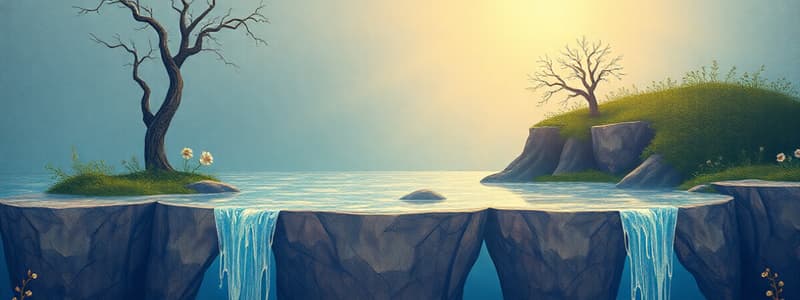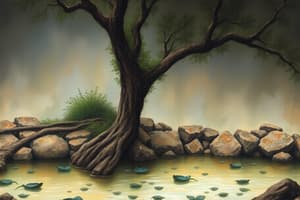Podcast
Questions and Answers
Canada has one of the highest total renewable water resources per capita worldwide.
Canada has one of the highest total renewable water resources per capita worldwide.
True (A)
The average annual precipitation in Canada is significantly greater than the global average.
The average annual precipitation in Canada is significantly greater than the global average.
False (B)
Canada comprises 20% of the world's total renewable water resources.
Canada comprises 20% of the world's total renewable water resources.
False (B)
Agriculture is a sector in Canada that has high consumption of water.
Agriculture is a sector in Canada that has high consumption of water.
Canada is considered water poor compared to the majority of countries worldwide.
Canada is considered water poor compared to the majority of countries worldwide.
The average annual runoff in Canada is 330 mm.
The average annual runoff in Canada is 330 mm.
Thermal power generation in Canada consumes most of the water it withdraws.
Thermal power generation in Canada consumes most of the water it withdraws.
Canada has a lower percentage of the world's renewable runoff than many other countries.
Canada has a lower percentage of the world's renewable runoff than many other countries.
Saltwater intrusion occurs when a layer of salt water lies above a freshwater aquifer.
Saltwater intrusion occurs when a layer of salt water lies above a freshwater aquifer.
In the spring, the hydrograph of the North Saskatchewan River shows a first peak due to rainstorms.
In the spring, the hydrograph of the North Saskatchewan River shows a first peak due to rainstorms.
River floods in Ontario are often caused by short-duration rainfall associated with severe thunderstorms.
River floods in Ontario are often caused by short-duration rainfall associated with severe thunderstorms.
The North Saskatchewan River's watershed covers an area of approximately 130,000 square kilometers.
The North Saskatchewan River's watershed covers an area of approximately 130,000 square kilometers.
Groundwater seepage into streams is highest during the winter months.
Groundwater seepage into streams is highest during the winter months.
Global warming has no effect on irrigation cycles and stream flow.
Global warming has no effect on irrigation cycles and stream flow.
Ice jams can contribute to flooding by blocking the normal discharge of a river.
Ice jams can contribute to flooding by blocking the normal discharge of a river.
Once a cold snap occurs in November, it prevents any further flow in the river.
Once a cold snap occurs in November, it prevents any further flow in the river.
The water table is typically higher in valleys than on elevated land surfaces.
The water table is typically higher in valleys than on elevated land surfaces.
Aquifers are layers of impermeable rock that can hold large amounts of water.
Aquifers are layers of impermeable rock that can hold large amounts of water.
Evapotranspiration is a process that involves only evaporation from the soil.
Evapotranspiration is a process that involves only evaporation from the soil.
Groundwater depletion occurs when withdrawal exceeds the rate of infiltration.
Groundwater depletion occurs when withdrawal exceeds the rate of infiltration.
Contamination of groundwater can occur when pollutants reach the water table through infiltration.
Contamination of groundwater can occur when pollutants reach the water table through infiltration.
The cone of depression occurs when the water table around a well rises due to excessive withdrawal.
The cone of depression occurs when the water table around a well rises due to excessive withdrawal.
Aquifers are typically made up of layers of clay and shale that allow water to flow freely.
Aquifers are typically made up of layers of clay and shale that allow water to flow freely.
Rapid urbanization and industrial development increase the demand for groundwater resources.
Rapid urbanization and industrial development increase the demand for groundwater resources.
The Great Lakes renew 10% of their water supply annually.
The Great Lakes renew 10% of their water supply annually.
Parts of British Columbia receive an annual runoff of over 2000mm.
Parts of British Columbia receive an annual runoff of over 2000mm.
The majority of annual stream flow in the Saskatchewan River Basins occurs in winter.
The majority of annual stream flow in the Saskatchewan River Basins occurs in winter.
Human societies have adapted to control the flow of water through the use of natural ecosystems.
Human societies have adapted to control the flow of water through the use of natural ecosystems.
Year-to-year variability in river flow can range from 1.7 billion to 13.2 billion m³.
Year-to-year variability in river flow can range from 1.7 billion to 13.2 billion m³.
Increased withdrawals of groundwater during dry periods can enhance base flow in streams and rivers.
Increased withdrawals of groundwater during dry periods can enhance base flow in streams and rivers.
The concept of 'death of stationarity' implies that future water availability can be predicted reliably based on past data.
The concept of 'death of stationarity' implies that future water availability can be predicted reliably based on past data.
Water pollution can originate from both point sources and non-point sources.
Water pollution can originate from both point sources and non-point sources.
Eutrophication is accelerated by nitrogen runoff from agricultural fields.
Eutrophication is accelerated by nitrogen runoff from agricultural fields.
The reduction of base flows during summer months can lead to poor habitat quality for aquatic organisms.
The reduction of base flows during summer months can lead to poor habitat quality for aquatic organisms.
Treatment plant effluents are diluted by increased surface water flows in rivers.
Treatment plant effluents are diluted by increased surface water flows in rivers.
Atmospheric deposition can introduce heavy metals into water bodies.
Atmospheric deposition can introduce heavy metals into water bodies.
The Walkerton incident was a result of surface water contamination affecting a municipal well.
The Walkerton incident was a result of surface water contamination affecting a municipal well.
Flashcards are hidden until you start studying
Study Notes
Groundwater Basics
- Groundwater is found in the saturated zone, where pore spaces in bedrock or regolith are completely filled with water.
- The water table is the top of the saturated zone, and its location varies based on topography, with higher levels under hills and lower levels in valleys.
- Groundwater flows very slowly, driven by gravity.
- Aquifers are underground layers of porous rock, like sandstone, saturated with water and allowing for free flow.
- Aquitards are layers of less permeable rock, like clay or shale, that hold little water.
- Springs form when porous rock overlies impervious rock, allowing groundwater to move freely through the aquifer.
Groundwater Management Challenges
- Rapid groundwater withdrawal can have serious environmental impacts.
- Increased urban populations and industrial developments lead to higher water demands, often met by new wells or increased reliance on surface water.
- Agriculture in dry climates heavily relies on irrigation water from pumped wells.
- Water table depletion occurs when extraction exceeds infiltration, leading to a lowering of the water table and a cone of depression around the well.
- Groundwater contamination can be a significant problem.
- Pollutants infiltrating the ground can reach the water table, posing a threat to water quality.
- The disposal of solid wastes, especially in developed countries with advanced industrial economies, can also contribute to groundwater contamination.
- Saltwater intrusion in coastal wells is a risk when freshwater aquifers are depleted. Saltwater, being denser than freshwater, can rise from below and contaminate the wells.
Stream Flow and Flooding
- Stream discharge is influenced by base flow (groundwater seepage) and direct input from runoff.
- Hydrographs show the variations in stream flow over time.
- River floods occur when the discharge exceeds the capacity of the river channel.
- Causes of river floods include intense rainfall, ice jams, and snowmelt.
Assessing Canada's Water Resources
- Canada possesses abundant water resources, with a total freshwater supply exceeding 20% of the global total.
- However, distribution is uneven, with some regions experiencing significant water scarcity.
- Runoff variability is high across the country, with the majority of the annual flow often concentrated in spring due to snowmelt.
- Climate change is leading to increased variability in water availability, challenging water management practices.
- Water withdrawals can impact base flow in streams and rivers, particularly during dry periods, affecting aquatic habitats and water quality.
- Water pollution from point sources (e.g., sewage) and non-point sources (e.g., agricultural runoff) poses a threat to water ecosystems and human health.
- Water pollution can lead to eutrophication, reduced dissolved oxygen levels, and the release of toxic substances like heavy metals and PCBs.
Studying That Suits You
Use AI to generate personalized quizzes and flashcards to suit your learning preferences.




